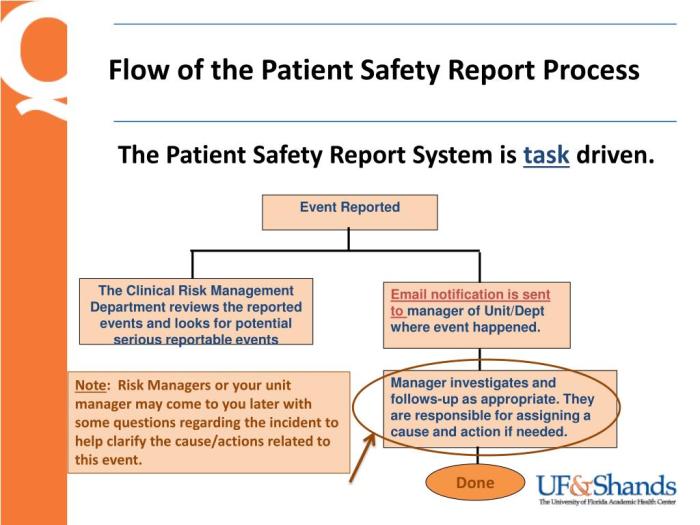
Dive into the world of Patient Safety Reporting Systems, where the focus is on improving healthcare quality through effective reporting mechanisms. From identifying key components to highlighting successful implementations, this topic delves deep into ensuring patient safety in healthcare settings.
Patient Safety Reporting Systems

Patient safety reporting systems play a crucial role in healthcare by allowing healthcare professionals to report incidents, near-misses, and errors that could potentially harm patients. These systems are designed to improve patient safety, enhance quality of care, and prevent future adverse events.
Key Components of an Effective Patient Safety Reporting System
An effective patient safety reporting system typically includes the following key components:
- User-friendly interface for easy reporting by healthcare staff
- Confidentiality and anonymity to encourage reporting without fear of reprisal
- Clear guidelines and criteria for reporting incidents
- Timely feedback and follow-up on reported incidents
- Integration with existing quality improvement processes
Importance of Transparency in Patient Safety Reporting
Transparency in patient safety reporting is essential to building trust among healthcare providers, patients, and the public. By openly sharing information about adverse events and near-misses, healthcare organizations can demonstrate their commitment to learning from mistakes, improving patient care, and preventing future harm.
Examples of Successful Implementation of Patient Safety Reporting Systems
One notable example of successful implementation of a patient safety reporting system is the Veterans Health Administration’s National Center for Patient Safety (NCPS). The NCPS developed a comprehensive reporting system that allows healthcare providers to report incidents, analyze data, and implement interventions to improve patient safety across the entire VA healthcare system.
Importance of Patient Safety

Patient safety is a top priority in healthcare as it directly impacts the well-being and outcomes of patients. Ensuring patient safety involves preventing harm from medical errors, infections, falls, and other adverse events during the course of healthcare delivery.
Impact of Medical Errors on Patient Safety
Medical errors can have severe consequences on patient safety, leading to adverse outcomes such as prolonged hospital stays, disability, or even death. These errors can occur at any stage of the healthcare process, from diagnosis to treatment, medication administration, and discharge.
Comparison of Traditional vs. Modern Patient Safety Reporting Systems
- Traditional reporting systems rely on manual documentation and may be prone to errors, delays, and incomplete information. In contrast, modern electronic patient safety reporting systems allow for real-time reporting, analysis, and identification of trends to address issues promptly.
- Electronic systems also facilitate easier data sharing among healthcare providers, enabling a more comprehensive view of patient safety across different departments and facilities.
Contribution of Patient Safety Reporting Systems to Quality Improvement
- By capturing and analyzing data on adverse events, near misses, and unsafe conditions, patient safety reporting systems help identify areas for improvement in healthcare processes and protocols.
- Through the implementation of corrective measures based on the insights gained from these systems, healthcare organizations can enhance the quality of care, reduce risks, and prevent future incidents, ultimately improving patient outcomes.
In conclusion, Patient Safety Reporting Systems play a crucial role in enhancing healthcare quality and promoting transparency. By embracing modern reporting systems, healthcare facilities can continuously strive for excellence in patient care and safety.
FAQs
What is the primary goal of patient safety reporting systems?
The main goal is to improve patient safety by identifying and addressing potential risks and errors in healthcare settings.
How do modern electronic reporting systems differ from traditional methods?
Modern electronic systems offer real-time reporting, easier data analysis, and more efficient communication compared to traditional paper-based systems.





